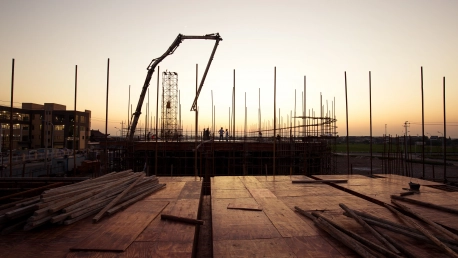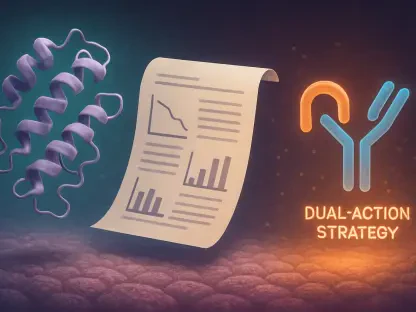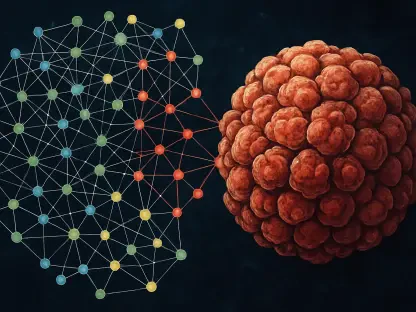The fusion of synthetic biology (SynBio) with architecture is marking the beginning of a revolutionary shift towards eco-friendly building methods. At the forefront is Ginger Dosier with her pioneering company, Biomason; she represents the future of green construction. SynBio’s integration with architectural practices promises to drastically reduce carbon footprints, steering the industry towards sustainable development.Innovations like those led by Dosier utilize living organisms to create building materials. For instance, Biomason uses bacteria to grow biocement in a process that sequesters carbon, radically cutting greenhouse gas emissions compared to traditional cement production. This technique exemplifies the kind of groundbreaking changes SynBio can bring to architecture, potentially transforming the way we construct buildings.Dosier’s work is just one piece of a larger puzzle that marries scientific advancement with architectural design. As this trend progresses, we can expect to see a surge in constructions that are not just environmentally neutral but positively restorative, offering a way to counteract the industry’s historically heavy environmental toll. Such advancements signal an optimistic future for sustainable urban development, where buildings are crafted with the well-being of the planet firmly in mind. This is a change that goes beyond mere energy efficiency—it’s about reimagining our built environment to work with nature, rather than against it.
The Emergence of Bio-Influenced Construction Materials
The Role of Biomason and Biocement in Architecture
Biocement is one of SynBio’s most profound contributions to sustainable architecture, with Biomason at the forefront of its application. The company leverages living microorganisms to produce cement, a process that essentially grows the material without the carbon footprint characteristic of traditional cement manufacturing. This method redefines the future of construction materials, fostering an architectural mindset that prioritizes sustainability from inception to completion.Biocement is not simply about reducing emissions; it challenges the established norms of material science. Dosier’s approach with Biomason demonstrates that biologically engineered materials can meet, if not surpass, the performance expectations of their conventional counterparts, offering architects and builders novel solutions that are in harmony with our planet’s ecosystem.
Building for Future Climates and Sustainability
The battle against climate change demands that architects and builders adopt materials that stand the test of time and the elements. The industry must anticipate future climates and seek out materials like those inspired by SynBio, which are designed to endure extreme weather conditions and environmental stressors. The focus is not only on durability but also on how these materials interact with the environment during their lifecycle.As bio-informed materials find their way into the market, their capacity to merge longevity with ecological compatibility becomes paramount. With an eye on the long horizon, designers are recognizing the potential of SynBio to yield architectural components that contribute positively to sustainability objectives, marking a new age of thoughtful, long-lasting design.
Redefining Material Life Cycles and Environmental Impacts
The Construction Industry’s Ecological Footprint
The construction industry’s ecological footprint is a pressing concern for architects aware of the impact that buildings have on the planet. The land use, resource extraction, and biodiversity loss associated with traditional building practices demand a strategic reevaluation. This is where SynBio steps in, fostering the creation of materials that are not simply useful in the short term but also considerate of their environmental legacy.The directed use of materials in architecture, alongside minimized impact on the land utilized, encapsulates a broader trend of sustainability in construction. These emerging materials come with a promise: to coexist with biodiversity rather than displacing it. They embody a profound shift towards a holistic appraisal of carpentry that includes the origins, life, and eventual return of building materials to the Earth.
Exploring the Long-Term Environmental Effects
Dosier is at the forefront of a movement that calls for a transformation in how we produce and dispose of construction materials. The environmental impact of these materials can’t be reduced to just the emissions from their creation; we must consider their entire lifecycle, including how they’re discarded. Materials engineered through Synthetic Biology (SynBio) offer a compelling alternative, designed to be environmentally benign from cradle to grave.The weight of man-made materials on Earth has become a pressing environmental issue. Dosier is promoting a shift in the building sector towards biodegradable materials. These biomaterials are engineered to work in harmony with natural processes, decomposing without damage to the ecosystem after their use in construction.Such innovations in SynBio are key; they propose a new generation of construction materials that are produced sustainably and can safely return to the earth, mirroring the regenerative cycles found in nature. This approach presents a sustainable pathway for the construction industry, minimizing the environmental footprint of buildings and infrastructure throughout their lifespan, including their eventual deconstruction. It’s a vision for a greener future where the materials we build with are as considerate of the environment in their end as they are in their use.
Decarbonizing Construction Materials
Combatting Greenhouse Gas Emissions from Buildings
Buildings, through their operations and the materials they consume, represent a substantial chunk of global greenhouse gas emissions. Decarbonizing building materials is, therefore, a critical step towards meeting global climate targets. Dosier’s work points to an array of methods that can reduce the carbon footprint of these materials, such as the use of bio-based alternatives that lock away carbon or revising supply chain logistics to lessen emissions.Creating construction materials that actively sequester carbon is a revolutionary concept ushered in by SynBio. These materials don’t just passively exist; they function as carbon sinks, providing a dynamic solution to reducing atmospheric CO2. This focus on the materials’ lifecycle emissions is a vital component of the industry’s overhaul in favor of a greener future.
Pioneers in Sustainable Concrete Alternatives
In a groundbreaking effort to revolutionize the construction industry, companies like Prometheus Materials are pioneering sustainable alternatives to traditional concrete, known for its considerable carbon footprint. This innovator is leading the charge by fabricating building blocks from bio-based inputs, effectively circumventing the hefty CO2 emissions associated with conventional cement production. Complementing this progress, Minus Materials is making strides with their development of eco-friendly, biodegradable concrete additives. These additives not only enhance the structural strength of concrete but also reduce overall material consumption.At the forefront of this innovation wave is Basilisk, which has developed an incredible self-healing concrete. This technological marvel promises to extend the life of concrete structures significantly, reducing the need for frequent repairs and maintenance.Collectively, these trailblazing companies are galvanizing the construction materials sphere, with a clear focus on functionality coupled with environmental stewardship. Through these advanced materials, the construction sector is poised to emerge as a champion of sustainability, reducing its ecological impact while maintaining the integrity and resilience of its structures.
Cross-Industry Material Innovations
Advancements in Sustainable Biofibers
The textile industry’s foray into sustainable fibers swiftly has implications for architecture. Developments in materials derived from organic sources like lignin and seaweed or lab-grown timber suggest a future independent from environmentally destructive resources. These biofibers signal an impending shift in building practices, one that aims to mitigate deforestation and resource depletion while embracing the principles of the circular economy.Bio-based materials pave the way for a new chapter in construction, one that couples innovation with conservatism. By capitalizing on research within textiles and fashion, architecture benefits from a ripple effect of sustainable material usage, demonstrating the interconnectedness of industry advancements and the shared responsibility towards ecological stewardship.
Evolving Paints and Coatings
The realm of paints and coatings has evolved dramatically, with companies like Pneuma Bio at the forefront of this transformation. They’re redefining the industry by developing paints that not only protect surfaces but also purify the air. By infusing paint with living algae, these innovative coatings absorb pollutants, showcasing how materials can actively contribute to environmental health.This fusion of biology with material science symbolizes a significant shift towards eco-consciousness in the industry. Advancements are not just about minimizing the harmful impacts of traditional ingredients such as solvents and pigments but are also about designing substances that actively benefit our planet. As a result, we’re witnessing the emergence of sustainable paints that offer both protective functionalities and the capacity to generate energy, indicating a new era for coatings that are as beneficial for the environment as they are for the surfaces they cover.
Localized Solutions and Biodiversity
The Importance of Material Diversity and Adaptation
Understanding that one-size-fits-all is not a feasible approach to sustainable architecture, the industry is moving towards more localized and diversified use of materials. This shift away from a universal standard ensures that each building project is responsive to the unique environmental and cultural context it occupies. Material diversity and specific adaptation are essential considerations for architecture that thrives both aesthetically and ecologically.Embracing the variance of local environments encourages architecture that not only merges seamlessly with its surroundings but also supports the native biodiversity. It requires a deep knowledge of regional resources and the willingness to adapt and innovate with materials that align with the geographical and cultural fabric of a place.
Collaboration in Material Science and Technology
In her call for a collaborative ethos, Dosier recognizes the importance of drawing from a breadth of disciplines and perspectives to conceive materials that address the specific challenges of different locales. By involving a diverse range of experts and stakeholders in the development of new technologies, the industry moves closer to achieving a balance between human needs and environmental preservation.This inclusive approach, championed by Dosier, is not only about innovation; it’s about crafting a dialogue — one in which material science and technology engage with traditional knowledge and local wisdom to generate solutions that are both sustainable and effective. Synergy in these sectors is quintessential for cultivating an architectural future that is resilient, adaptable, and deeply integrated with the principles of sustainability.









